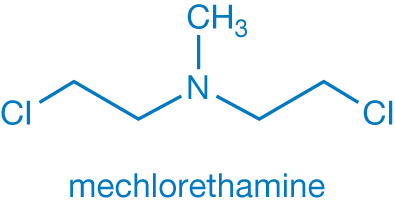Author(s): AliBukhari and AshkanEmadi
The inception of chemotherapy as a therapeutic agent is built on the foundation of biochemical warfare. The synthesis of mustard gas in 1854 and its subsequent use during World War I highlighted its gastrointestinal and myelosuppressive toxicity. After swapping out the sulfide group in favor of an amino group, chlormethine (mechlorethamine) became the first evaluated chemotherapeutic agent of the modern age. It became the prototype medication for alkylating agents.

An alkyl (e.g., methyl, ethyl, propyl) is an alkane (e.g., methane, ethane, propane) with one hydrogen missing. Alkyls are highly active radicals that form covalent bonds with different molecules; hence, they are always attached to other molecular fragments. MOPP (a combination of mechlorethamine, vincristine [oncovin], procarbazine, and prednisone) is one of the first regimens that was used with curative intent in oncology.
Alkylating agents directly damage the DNA via DNA intra- and interstrand covalent crosslinking, preventing the cells from reproducing. Generally, they are cell cycle–dependent but not cell cycle phase-specific. Bone marrow suppression, including leukopenia, neutropenia, lymphopenia, anemia, and thrombocytopenia, is a common adverse event of all alkylating agents. Other common adverse events include gonadal toxicity/failure, carcinogenicity, and nausea and vomiting. All alkylating agents can cause therapy-related myeloid neoplasms (t-MN), including acute myeloid leukemia (AML) and myelodysplastic syndromes (MDSs), that usually occur 5 to 7 years after treatment and involve abnormalities of chromosome 5 and /or 7.
There are different types of alkylating agents based on the chemical structures:
- Nitrogen mustard: cyclophosphamide, ifosfamide, chlorambucil, melphalan, bendamustine, mechlorethamine
- Nitrosourea: streptozocin, carmustine (BCNU), lomustine (CCNU)
- Triazine:dacarbazine, temozolomide
- Alkyl sulfonate: busulfan
- Busulfan is used as part of conditioning regimens for allogeneic stem cell transplant and causes pulmonary fibrosis (busulfan lung), hepatic veno-occlusive disease (VOD), skin hyperpigmentation, and seizure. Prophylactic anticonvulsants should be used with busulfan-containing conditioning regimens.
- Ethylenimine: thiotepa
- Platinum agents: cisplatin, carboplatin, oxaliplatin
Most of these alkylating agents are metabolized hepatically and excreted in the urine; dose adjustment for renal dysfunction and severe hepatic dysfunction is often required.